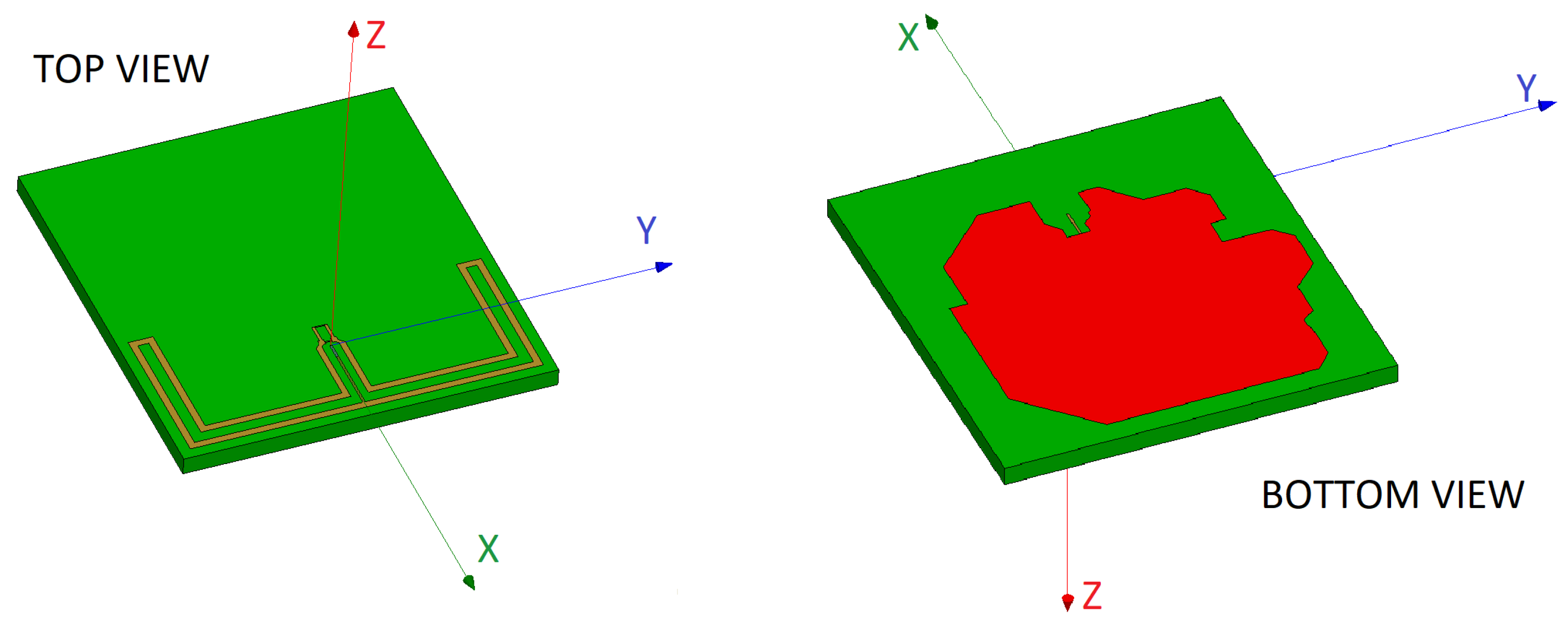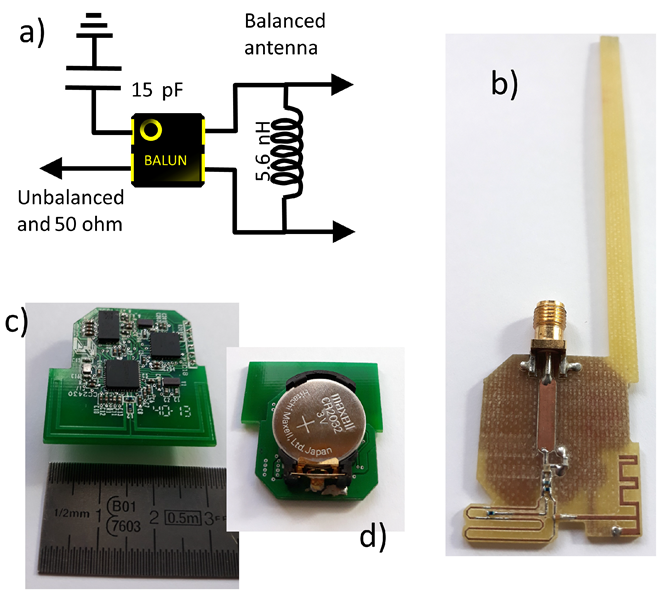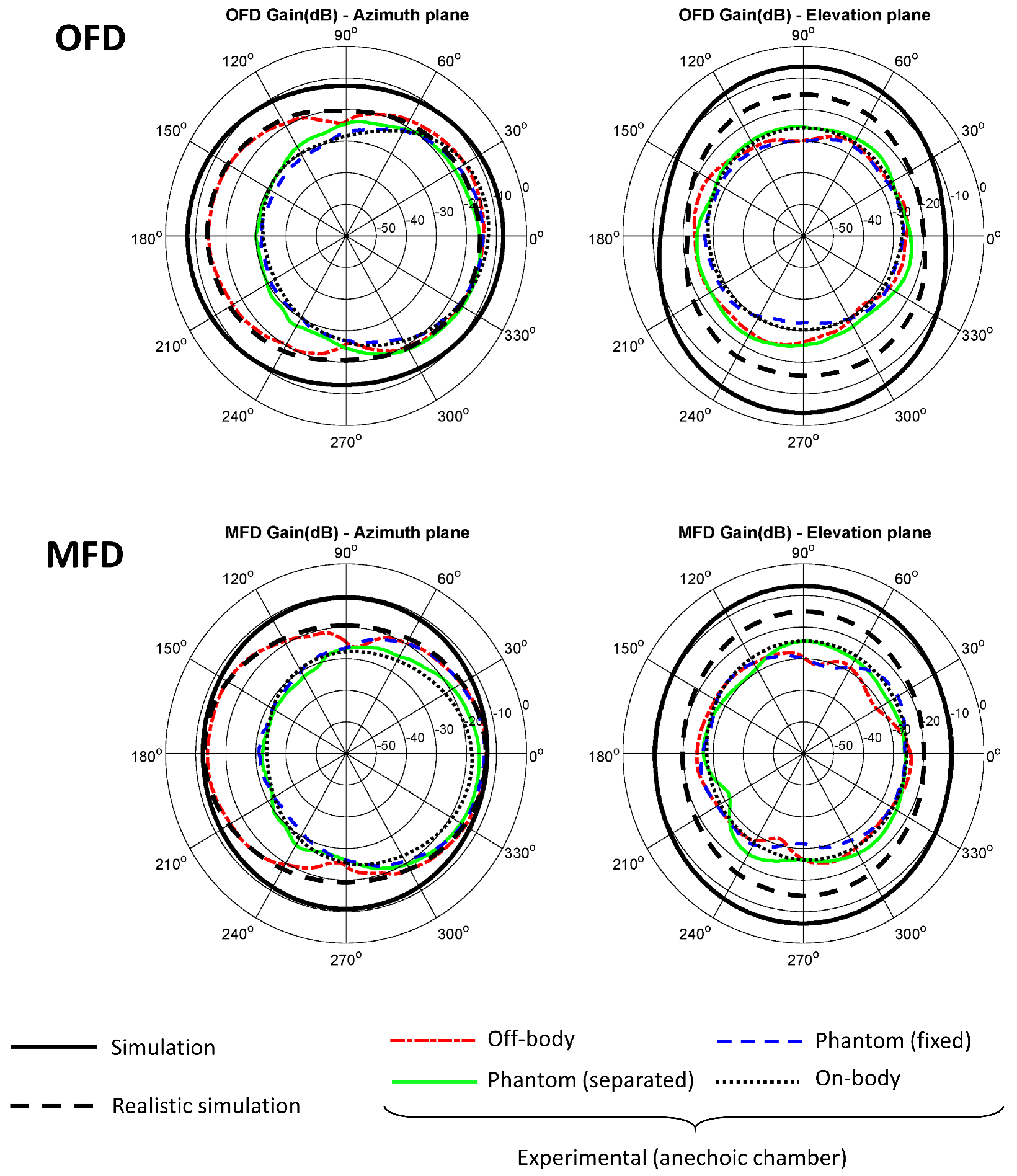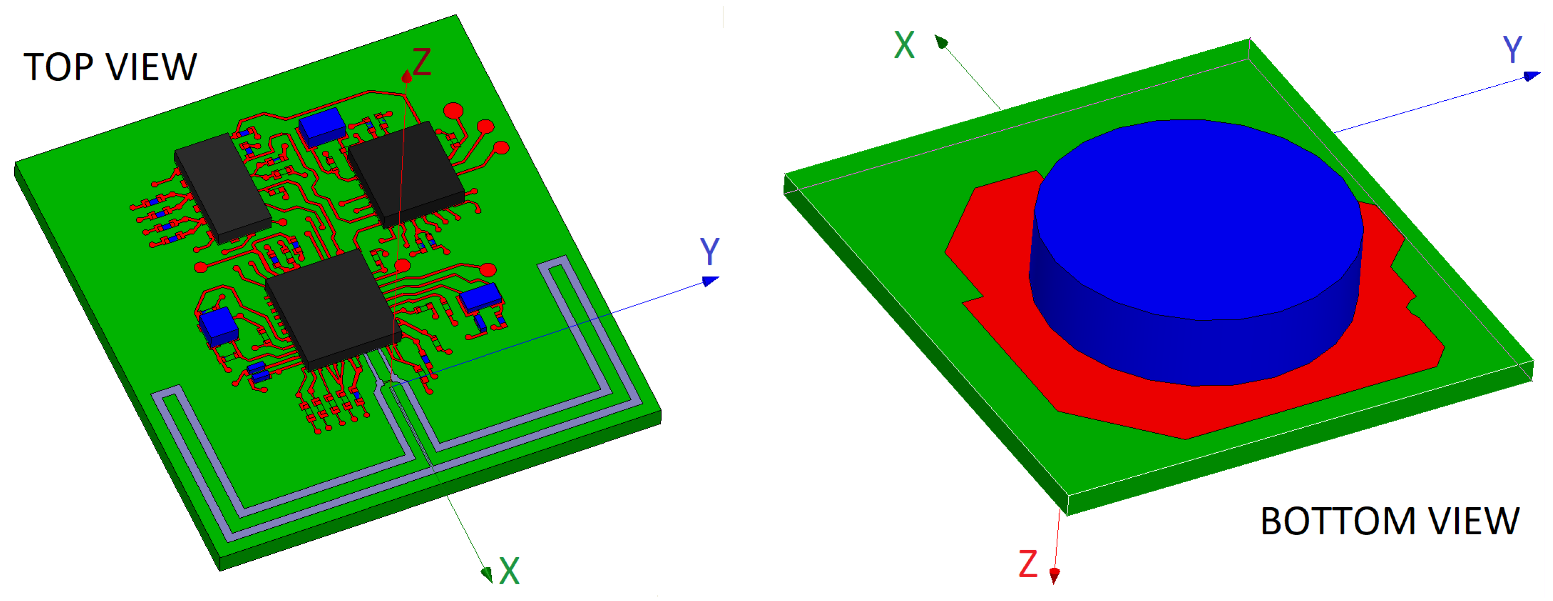Lessons Learned about the Design and Active Characterization of On-Body Antennas in the 2.4 GHz Frequency Band
Abstract
:1. Introduction
2. Materials and Methods
2.1. Issues Related to the Biomedical Application
2.2. Issues Related to the Communication Technology Selection
2.3. Issues Related to the Design and Simulation Process
- A previously defined hardware design for the application case (fall detection): accelerometer, microcontroller and auxiliary components.
- The transceiver to be used is the CC2431 from Texas Instruments.
- Microstrip technology selected for the antenna design.
- The hardware defines a location of components, a top layer and a ground plane whose dimensions and size are optimized, which will not be modified during the antenna design process, so that the antenna will be incorporated into the previous hardware design.
- Eight designs derived from generic antennas: two types of monopole, three types of dipole, three types of circular antennas around the hardware, and a yagi antenna adapted to the microstrip technology [52].
- Starting design of the antennas: All the antennas were implemented in the electromagnetic simulation software through different design tests for adaptation to a basic implementation of the sensor hardware that considered the dimensions of the ground plane and the thickness of the substrate. Figure 1 shows as an example an implementation of one of the analyzed antennas.
- Selection of sensitive dimensions: Through an analysis process, the dimensions that allowed the adjustment of the resonant frequency and bandwidth were selected.
- Iterative optimization process of the antennas: The radiation characteristics of each of the designs were optimized through an iterative adjustment of sizes, positions and values of the discrete impedance matching components (resistors, inductors, and capacitors). All the antennas were tuned by modifying the adjustable parameters of the antennas to meet the preliminary conditions related to the antenna design and to robustly comply with the design requirements established in the Section 2.2, maintaining a trade-off with the minimization of the device size. In general, the dimensions were changed iteratively to get, if possible, a resonant frequency centered around 2.45 GHz and return losses greater than 10 dB in the frequency range between 2.4 and 2.5 GHz.
- Sensitivity analysis of the antennas: On the selected dimensions a sensitivity analysis was performed to rule out those configurations very sensitive to small size changes.
- Evaluation of the radiation pattern of the antennas to select those configurations that provided a trade-off between the gain and an omnidirectional radiation pattern.
- Orthogonal Folded Dipole (OFD): A folded dipole with balanced output, but with an orthogonal shape in order to be adapted to the circuit size, thus reducing the overall size of the device. The use of a balun is not necessary since OFD is already a balanced antenna.
- Matched Folded Dipole (MFD): A modification of a folded dipole in order to follow to the shape of the device, thus reducing the overall size.
- Modified MIFA (MIFAm): Despite its small size, this antenna is not balanced. Therefore, an additional balun was designed according to the characteristics of both antenna and sensor device.
- Modified IFA (IFAm): It requires a larger surface and needs to be matched with a balun too.
2.4. Issues Related to the Anechoic Chamber Measurements
- Off-body: This condition was emulated following the procedure described above using the non-conductive PVC support and electromagnetic radiation attenuation absorbers inside the support as Figure 4 shows.
- Phantom to emulate on-body condition (separated): In this case, the space between the antenna and the metal support was occupied by a phantom of biological material to emulate the presence of the human body. Containers of liquids or gels that simulate the electrical properties of the body tissues have been used [29], but in this work a biological material of similar structure (skin, fat and muscle) is proposed. A chicken for food consumption was selected to implement the phantom (2.45 kg, clean inside, featherless at room temperature), which was fixed to the support. The phantom was covered by a very thin film (15 μm) of non-conductive material (polyethylene and polypropylene) to prevent electrical conduction effects. The antenna was arranged to maintain a separation of 0.5 cm from the surface of the phantom and located over the center of the area corresponding to the breast.
- Phantom to emulate on-body condition (fixed): Equivalent to the previous condition, but in this case the sensor was arranged in direct contact with the surface of the phantom. The side of the PCB (FR4 epoxi) in contact with the phantom surface was free of copper, and the antenna was located on the opposite side of the PCB.
- On-body: In this case, the metallic support was discarded, placing on its position a volunteer (male, 42 years of age, height of 1.73 cm and weight of 82 kg). Each of the P2 prototypes were placed on the volunteer according to Section 2.1. In each experiment, the volunteer oriented himself inside the anechoic chamber towards a fixed azimuth angle using a system of visual references. The average value of thirty measurements was recorded. A greater number of measurements was necessary in this case to estimate the mean value due to the increase in variability as a consequence of performing measurements on a person. Different experiments were carried out to go through the azimuthal plane in increments of 15°. In order to obtain the elevation plane pattern, the volunteer was oriented in a direction transverse to the line connecting Tx with Rx, manually varying the orientation angle of the sensor on the volunteer’s back in increments of 15° in each of the experiments.
3. Results
3.1. Simulation Results
3.2. Anechoic Chamber Results
4. Discussion
5. Conclusions
Author Contributions
Funding
Acknowledgments
Conflicts of Interest
Abbreviations
| BLE | Bluetooth Low Energy |
| BSN | Body sensor network |
| DAD | Decision-Analysis Device |
| FEM | Finite-element-method |
| IFA | Inverted F antenna |
| IFAm | Modified IFA |
| MFD | Matched folded dipole |
| MIFA | Meandered inverted F antenna |
| MIFAm | Modified MIFA |
| OFD | Orthogonal folded dipole |
| PCB | printed circuit board |
| PVC | Polyvinyl chloride |
| P1 | First set of prototypes |
| P2 | Complete SoM prototypes |
| Rx | Receiver |
| SoM | Sensor of Movement |
| Tx | Transmitter |
References
- Chen, C.; Wang, Z.; Li, W.; Chen, H.; Mei, Z.; Yuan, W.; Tao, L.; Zhao, Y.; Huang, G.; Mei, Y.; et al. Novel flexible material-based unobtrusive and wearable body sensor networks for vital sign monitoring. IEEE Sens. J. 2019, 19, 8502–8513. [Google Scholar] [CrossRef]
- Niu, S.; Matsuhisa, N.; Beker, L.; Li, J.; Wang, S.; Wang, J.; Jiang, Y.; Yan, X.; Yun, Y.; Burnett, W.; et al. A wireless body area sensor network based on stretchable passive tags. Nat. Electron. 2019, 2, 361–368. [Google Scholar] [CrossRef]
- Pirbhulal, S.; Zhang, H.; Wu, W.; Mukhopadhyay, S.; Zhang, Y. Heart-beats based biometric random binary sequences generation to secure wireless body sensor networks. IEEE Trans. Biomed. Eng. 2018, 65, 2751–2759. [Google Scholar] [CrossRef] [PubMed]
- Fernandes, D.; Ferreira, A.; Abrishambaf, R.; Mendes, J.; Cabral, J. Survey and taxonomy of transmissions power control mechanisms for wireless body area networks. IEEE Commun. Surv. Tutor. 2018, 20, 1292–1328. [Google Scholar] [CrossRef]
- Mihovska, A.; Sarkar, M. Smart Connectivity for Internet of Things (IoT) Applications. In New Advances in the Internet of Things; Studies in Computational Intelligence; Yager, R.R., Espada, J.P., Eds.; Springer: Berlin/Heidelberg, Germany, 2018. [Google Scholar]
- Wan, J.; Al-awlaqi, M.; Li, M.; O’Grady, M.; Gu, X.; Wang, J.; Cao, N. Wearable IoT enabled real-time health monitoring system. Eurasip J. Wirel. Commun. Netw. 2018, 298, 1–10. [Google Scholar] [CrossRef]
- Perumal, K.; Manoharan, P. A comparative analysis of energy-efficient protocols for WBAN on heterogeneous transceivers. J. Test. Eval. 2019, 47, 3912–3927. [Google Scholar] [CrossRef]
- Dumanli, S.; Sayer, L.; Mellios, E.; Fafoutis, X.; Hilton, G.; Craddock, I. Off-body antenna wireless performance evaluation in a residential environment. IEEE Trans. Antennas Propag. 2017, 65, 6076–6084. [Google Scholar] [CrossRef] [Green Version]
- Badreddine, W.; Chaudet, C.; Petruzzi, F.; Potop-Butucaru, M. Broadcast strategies and performance evaluation of IEEE 802.15.4 in wireless body area networks WBAN. Ad Hoc Netw. 2020, 97, 102006. [Google Scholar] [CrossRef] [Green Version]
- Rismanian Yazdi, F.; Hosseinzadeh, M.; Jabbehdari, S. A priority-based MAC protocol for energy consumption and delay guaranteed in Wireless Body Area Networks. Wirel. Pers. Commun. 2019, 108, 1677–1696. [Google Scholar] [CrossRef]
- Ngo, M.; La, Q.; Leong, D.; Quek, T.; Shin, H. User behavior driven mac scheduling for body sensor networks: A cross-layer approach. IEEE Sen. J. 2019, 19, 7755–7765. [Google Scholar] [CrossRef]
- Rezaie, H.; Ghassemian, M. An adaptive algorithm to improve energy efficiency in wearable activity recognition systems. IEEE Sens. J. 2017, 17, 5315–5323. [Google Scholar] [CrossRef]
- Velusamy, B.; Pushpan, S. An enhanced channel access method to mitigate the effect of interference among Body Sensor Networks for smart healthcare. IEEE Sens. J. 2019, 19, 7082–7088. [Google Scholar] [CrossRef]
- Hasan, K.; Biswas, K.; Ahmed, K.; Nafi, N.; Islam, M. A comprehensive review of wireless body area network. J. Netw. Comput. Appl. 2019, 143, 178–198. [Google Scholar] [CrossRef]
- Saboor, A.; Ahmad, R.; Ahmed, W.; Kiani, A.; Moullec, Y.; Alam, M. On research challenges in hybrid medium-access control protocols for IEEE 802.15.6 WBANs. IEEE Sens. J. 2019, 19, 8543–8555. [Google Scholar] [CrossRef]
- Vera, D.; Costa, N.; Roda-Sanchez, L.; Olivares, T.; Fernández-Caballero, A.; Pereira, A. Body area networks in healthcare: A brief state of the art. Appl. Sci. 2019, 9, 3248. [Google Scholar] [CrossRef] [Green Version]
- Rikli, N.E.; Al-Mazroa, A. Design of an adaptive medium access control protocol for wireless body area networks with heterogeneous sensors. Int. J. Distrib. Sens. Networks 2019, 15. [Google Scholar] [CrossRef] [Green Version]
- Wang, J.; Sun, Y.; Ji, Y.; Luo, S. Priority-aware price-based power control for co-located WBANs using stackelberg and bayesian games. Sensors 2019, 19, 2664. [Google Scholar] [CrossRef] [Green Version]
- Felicio, J.; Costa, J.; Fernandes, C. Dual-band skin-adhesive repeater antenna for continuous body signals monitoring. IEEE J. Electromagn. Microwaves Med. Biol. 2018, 2, 25–32. [Google Scholar] [CrossRef]
- Bose, P.; Khaleghi, A.; Balasingham, I. In-body and off-body channel modeling for future leadless cardiac pacemakers based on phantom and animal experiments. IEEE Antennas Wirel. Propag. Lett. 2018, 17, 2484–2488. [Google Scholar] [CrossRef]
- Sáchez-Montero, R.; Camacho-Gómez, C.; López-Espí, P.; Salcedo-Sanz, S. Optimal design of a planar textile antenna for industrial scientific medical (ISM) 2.4 GHz wireless body area networks (WBAN) with the CRO-SL algorithm. Sensors 2018, 18, 1982. [Google Scholar] [CrossRef] [Green Version]
- Mohamadzade, B.; Hashmi, R.; Simorangkir, R.; Gharaei, R.; Rehman, S.; Abbasi, Q. Recent advances in fabrication methods for flexible antennas in wearable devices: State of the art. Sensors 2019, 19, 2312. [Google Scholar] [CrossRef] [PubMed] [Green Version]
- Magill, M.; Conway, G.; Scanlon, W. Tissue-independent implantable antenna for in-body communications at 2.36–2.5 GHz. IEEE Trans. Antennas Propag. 2017, 65, 4406–4417. [Google Scholar] [CrossRef] [Green Version]
- Wen, D.; Hao, Y.; Munoz, M.; Wang, H.; Zhou, H. A compact and low-profile MIMO antenna using a miniature circular high-impedance surface for wearable applications. IEEE Trans. Antennas Propag. 2018, 66, 96–104. [Google Scholar] [CrossRef]
- Pfeiffer, C. Fundamental efficiency limits for small metallic antennas. IEEE Trans. Antennas Propag. 2017, 65, 1642–1650. [Google Scholar] [CrossRef] [Green Version]
- Li, Y.; Kim, Y. Classification of human activities using variation in impedance of single on-body antenna. IEEE Antennas Wirel. Propag. Lett. 2017, 16, 541–544. [Google Scholar] [CrossRef]
- Soh, P.; Vandenbosch, G. Textile antennas for body area networks: Design strategies and evaluation methods. In Electromagnetics of Body-Area Networks: Antennas, Propagation, and RF Systems; Wiley: Hoboken, NJ, USA, 2016; pp. 1–25. [Google Scholar]
- Cheng, S.; Hallbjorner, P.; Rydberg, A.; Vanotterdijk, D.; van Engen, P. T-matched dipole antenna integrated in electrically small body-worn wireless sensor node. Microwaves Antennas Propag. 2009, 3, 774–781. [Google Scholar] [CrossRef]
- Tsolis, A.; Paraskevopoulos, A.; Alexandridis, A.; Whittow, W.; Chauraya, A.; Vardaxoglou, J. Design, realisation and evaluation of a liquid hollow torso phantom appropriate for wearable antenna assessment. Microwaves Antennas Propag. 2017, 11, 1308–1316. [Google Scholar] [CrossRef] [Green Version]
- Ferreira, D.; Pires, P.; Rodrigues, R.; Caldeirinha, R. Wearable textile antennas: Examining the effect of bending on their performance. IEEE Antennas Propag. Mag. 2017, 59, 54–59. [Google Scholar] [CrossRef]
- Popa, I.; Janhunen, J.; Mikhaylov, K. Performance evaluation of ZigBee and UWB wireless sensors under doppler effect in rotating mechanical structures. In Proceedings of the European Wireless Conference 2016, Oulu, Finland, 18–20 May 2016; pp. 488–493. [Google Scholar]
- Baker, D.; Du Toit, J. A compact 1 to 18 GHz planar spiral antenna for interferometer and other direction finding applications. In Proceedings of the IEEE-APS Topical Conference on Antennas and Propagation in Wireless Communications (APWC), Cape Town, South Africa, 2–7 September 2012; pp. 1016–1019. [Google Scholar]
- Naranjo, D.; Roa, L.; Reina, L.; Barbarov, G.; Callejón, A. Experimental characterization of active antennas for body sensor networks. In Proceedings of the XIII Mediterranean Conference on Medical and Biological Engineering and Computing, Seville, Spain, 25–28 September 2013; Volume 41, pp. 1853–1856. [Google Scholar]
- Naranjo, D.; Roa, L.; Reina, J.; Estudillo, M. Personalization and adaptation to the medium and context in a fall detection system. IEEE Trans. Inf. Technol. Biomed. 2012, 16, 264–271. [Google Scholar] [CrossRef]
- Raza, U.; Kulkarni, P.; Sooriyabandara, M. Low power wide area networks: An overview. IEEE Commun. Surv. Tutor. 2017, 19, 855–873. [Google Scholar] [CrossRef] [Green Version]
- Naranjo-Hernández, D.; Roa, L.; Reina-Tosina, J.; Estudillo-Valderrama, M.; Barbarov, G. Low-power platform and communications for the development of wireless body sensor networks. Int. J. Distrib. Sens. Netw. 2015, 1–13. [Google Scholar] [CrossRef]
- Texas Instruments. System-on-Chip for 2.4 GHz ZigBee(TM)/IEEE 802.15.4 with Location Engine (Rev. B). Available online: http://www.ti.com/lit/ds/symlink/cc2431.pdf (accessed on 29 December 2019).
- International Commission on Non-Ionizing Radiation Protection—ICNIRP. Guidelines for limiting exposure to time-varying electric, magnetic and electromagetic fields (up to 300 GHz). Health Phys. 2009, 97, 257–259. [Google Scholar] [CrossRef] [PubMed]
- Venkatraman, P.; Sureka, C. Fabrication and characterization of a 3D Positive ion detector and its applications. Nucl. Instrum. Methods Phys. Res. 2017, 872, 131–138. [Google Scholar] [CrossRef]
- Guan, S.; Xie, L.; Xue, S.; Wan, G. Displacement Sensor Based on Separated Inverted-F Antenna. In Proceedings of the 2019 IEEE International Conference on Computational Electromagnetics, Shanghai, China, 20–22 March 2019. [Google Scholar]
- Tseng, V.; Chang, C.Y. Linear tapered slot antenna for ultra-wideband radar sensor: Design consideration and recommendation. Sensors 2019, 19, 1212. [Google Scholar] [CrossRef] [PubMed] [Green Version]
- Lazaro, A.; Villarino, R.; Girbau, D. Design of tapered slot Vivaldi antenna for UWB breast cancer detection. Microw. Opt. Technol. Lett. 2011, 53, 639–643. [Google Scholar] [CrossRef]
- Norzeli, S.; Ismail, I.; Busu, M. Designing an UHF RFID reader antenna. In Proceedings of the 2012 IEEE Symposium on Humanities, Science and Engineering Research, Kuala Lumpur, Malaysia, 24–27 June 2012; pp. 599–602. [Google Scholar]
- Texas Instruments. Application Note AN040: Folded Dipole Antenna for CC2400, CC2420, CC2430, CC2431, and CC2480. Available online: http://www.ti.com/lit/an/swra093d/swra093d.pdf (accessed on 29 December 2019).
- Texas Instruments. Application Note AN043: Small Size 2.4 GHz PCB Antenna. Available online: http://www.ti.com/lit/an/swra117d/swra117d.pdf (accessed on 29 December 2019).
- Texas Instruments. Application Note DN0007: 2.4-GHz Inverted F Antenna. Available online: https://www.ti.com/lit/an/swru120d/swru120d.pdf (accessed on 29 December 2019).
- Soh, P.; Vandenbosch, G.; Wee, F.; Van Den Bosch, A.; Martinez-Vazquez, M.; Schreurs, D.P. Specific Absorption Rate (SAR) evaluation of biomedical telemetry textile antennas. In Proceedings of the IEEE MTT-S International Microwave Symposium Digest, Seattle, WA, USA, 2–7 June 2013. [Google Scholar]
- Dinesh, S.; Vivek Priyan, R.; Jothichitra, R. Design of implantable patch antenna for biomedical application. In Proceedings of the ICIIECS 2015—2015 IEEE International Conference on Innovations in Information, Embedded and Communication Systems, Coimbatore, India, 19–20 March 2015. [Google Scholar]
- Salim, M.; Pourziad, A. A novel reconfigurable spiral-shaped monopole antenna for biomedical applications. Prog. Electromagn. Res. Lett. 2015, 57, 79–84. [Google Scholar] [CrossRef] [Green Version]
- Yang, W.; Ma, K.; Yeo, K.; Lim, W.; Kong, Z. A compact dual-band meander-line antenna for biomedical applications. In Proceedings of the 2013 IEEE MTT-S International Microwave Workshop Series on RF and Wireless Technologies for Biomedical and Healthcare Applications, Singapore, 9–11 December 2013. [Google Scholar]
- Xiao, S.; Li, R. Antennas design for implantable medical devices. In Proceedings of the IEEE International Conference on Computational Electromagnetics, Hong Kong, China, 2–5 February 2015; pp. 61–63. [Google Scholar]
- Kakoyiannis, C.; Karanasiou, I.; Koutsoupidou, M.; Uzunoglu, N. A unidirectional wideband printed Quasi-Yagi antenna for microwave breast imaging. In Proceedings of the 9th European Conference on Antennas and Propagation, Lisbon, Portugal, 13–17 April 2015. [Google Scholar]
- Du, Z.; Viikari, V.; Ala-Laurinaho, J.; Tamminen, A.; Raaisaanen, A. Antenna pattern retrieval from reflection coefficient measurements with reflective loads. Prog. Electromagn. Res. 2014, 148, 15–22. [Google Scholar] [CrossRef] [Green Version]
- Gemio, J.; Parron, J.; de Paco, P.; Sacristan, J.; Baldi, A. Improving silicon integrated antennas by substrate micromachining: A study of etching patterns. Prog. Electromagn. Res. 2011, 117, 365–378. [Google Scholar] [CrossRef] [Green Version]
- Heinz, D.; Melber, A.; Brennan, M. Constant phase uniform current loop for detection of metallic objects using longitudinal magnetic field projection. In Proceedings of the International Society for Optical Engineering, Detection and Sensing of Mines, Explosive Objects, and Obscured Targets, Baltimore, MD, USA, 7 June 2013. [Google Scholar]
- Kildal, P.S.; Chen, X.; Orlenius, C.; Franzen, M.; Patane, C. Characterization of reverberation chambers for OTA measurements of wireless devices: Physical formulations of channel matrix and new uncertainty formula. IEEE Trans. Antennas Propag. 2012, 60, 3875–3891. [Google Scholar] [CrossRef] [Green Version]
- Frezza, F.; Pajewski, L.; Piuzzi, E.; Ponti, C.; Schettini, G. Radiation-enhancement properties of an X-band woodpile EBG and its application to a planar antenna. Int. J. Antennas Propag. 2014, 2014, 729187. [Google Scholar] [CrossRef]
- Texas Instruments. Anaren 0404 (BD2425N50200A00) Balun Optimized for Texas Instruments CC2430 Transceiver. Available online: http://www.ti.com/lit/an/swra156a/swra156a.pdf (accessed on 29 December 2019).
- Shamaileh, A. Realization of Miniaturized Multi-/Wideband Microwave Front-Ends. Ph.D. Thesis, University of Toledo, Toledo, OH, USA, 2015. [Google Scholar]
- Kunkemoller, G.; MaB, T.; Michel, A.K.; Kim, H.S.; Brose, S.; Danylyuk, S.; Xstaubner, T.; Juschkin, L. Extreme ultraviolet proximity lithography for fast, flexible and parallel fabrication of infrared antennas. Opt. Express 2015, 23, 25487–25495. [Google Scholar] [CrossRef] [PubMed] [Green Version]
- Al Shamaileh, K.; Qaroot, A.; Dib, N.; Sheta, A. Design and analysis of multifrequency Wilkinson power dividers using nonuniform transmission lines. Int. J. Microw. Comput. Aided Eng. 2011, 21, 526–533. [Google Scholar] [CrossRef]
- Abdipour, M.; Moradi, G.; Shirazi, R. Ultra-low noise active microstrip antenna. Int. J. Microw. Wirel. Technol. 2014, 6, 515–520. [Google Scholar] [CrossRef]
- Souza, E.; Oliveira, P.; D’Assunção, A.; Mendonça, L.; Peixeiro, C. Miniaturization of a microstrip patch antenna with a koch fractal contour using a social spider algorithm to optimize shorting post position and inset feeding. Int. J. Antennas Propag. 2019, 2019. [Google Scholar] [CrossRef]
- Mohanna, S.; Farahbakhsh, A.; Tavakoli, S.; Ghassemi, N. Reduction of Mutual Coupling and Return Loss in Microstrip Array Antennas Using Concave Rectangular Patches. Int. J. Microw. Sci. Technol. 2010, 2010. [Google Scholar] [CrossRef]
- Capela, G.G.; Santos, N.P.; Peixeiro, C. Experimental Fine-Tuning of Microstrip Patch Antennas. In Proceedings of the IEEE AP-S/URSI International Symp., Toronto, ON, Canada, 11–17 July 2010. [Google Scholar]
- Ji, Z.; Brace, C. Expanded modeling of temperature-dependent dielectric properties for microwave thermal ablation. Phys. Med. Biol. 2011, 56, 5249–5264. [Google Scholar] [CrossRef] [PubMed] [Green Version]
- Munoz, M.; Foster, R.; Hao, Y. On-body performance of wireless sensor nodes using IEEE 802.15.4. In Proceedings of the 5th European Conference on Antennas and Propagation, Rome, Italy, 11–15 April 2011; pp. 3783–3786. [Google Scholar]
- Varnoosfaderani, M.; Thiel, D.; Lu, J. A wideband capacitively fed suspended plate antenna for wearable wireless sensors. In Proceedings of the 2015 International Symposium on Antennas and Propagation, Hobart, Australia, 9–12 November 2015; pp. 1–4. [Google Scholar]









| Antenna | Type | Resonant Frequency | Bandwidth | Gain | Omnidirectionality |
|---|---|---|---|---|---|
| Folded dipole [44] | Original | ✔ | - | - | ✔ |
| Adaptation 1 (OFD) | ✔ | ✔ | ✔ | ✔ | |
| Adaptation 2 (MFD) | ✔ | ✔ | ✔ | ✔ | |
| Adaptation 3 | ✔ | - | - | ✔ | |
| MIFA [45] | Original | - | - | - | ✔ |
| Adapted (MIFAm) | ✔ | ✔ | ✔ | ✔ | |
| IFA [46] | Original | ✔ | - | - | ✔ |
| Adapted (IFAm) | ✔ | ✔ | ✔ | ✔ | |
| [47] | Original | - | - | - | ✔ |
| Adapted | ✔ | - | - | ✔ | |
| [23] | Original | - | - | - | - |
| Original | ✔ | ✔ | - | - | |
| [48] | Original | - | - | - | - |
| Adapted | ✔ | - | - | - | |
| [49] | Original | - | - | - | - |
| Original | ✔ | - | - | - | |
| [50] | Original | ✔ | - | - | - |
| - | Adapted | ✔ | ✔ | - | ✔ |
| [51] | Original | ✔ | - | - | - |
| Adapted | ✔ | - | - | ✔ | |
| Monopole 1 | Adapted | ✔ | - | - | ✔ |
| Monopole 2 | Adapted | ✔ | - | - | ✔ |
| Dipole 1 | Adapted | ✔ | - | - | ✔ |
| Dipole 2 | Adapted | ✔ | ✔ | - | ✔ |
| Dipole 3 | Adapted | ✔ | ✔ | - | ✔ |
| Circular 1 | Adapted | ✔ | - | - | ✔ |
| Circular 2 | Adapted | - | - | - | - |
| Circular 3 | Adapted | - | - | - | ✔ |
| Yagi | Adapted | ✔ | - | - | - |
© 2019 by the authors. Licensee MDPI, Basel, Switzerland. This article is an open access article distributed under the terms and conditions of the Creative Commons Attribution (CC BY) license (http://creativecommons.org/licenses/by/4.0/).
Share and Cite
Naranjo-Hernández, D.; Reina-Tosina, J.; Roa, L.M. Lessons Learned about the Design and Active Characterization of On-Body Antennas in the 2.4 GHz Frequency Band. Sensors 2020, 20, 224. https://doi.org/10.3390/s20010224
Naranjo-Hernández D, Reina-Tosina J, Roa LM. Lessons Learned about the Design and Active Characterization of On-Body Antennas in the 2.4 GHz Frequency Band. Sensors. 2020; 20(1):224. https://doi.org/10.3390/s20010224
Chicago/Turabian StyleNaranjo-Hernández, David, Javier Reina-Tosina, and Laura M. Roa. 2020. "Lessons Learned about the Design and Active Characterization of On-Body Antennas in the 2.4 GHz Frequency Band" Sensors 20, no. 1: 224. https://doi.org/10.3390/s20010224





